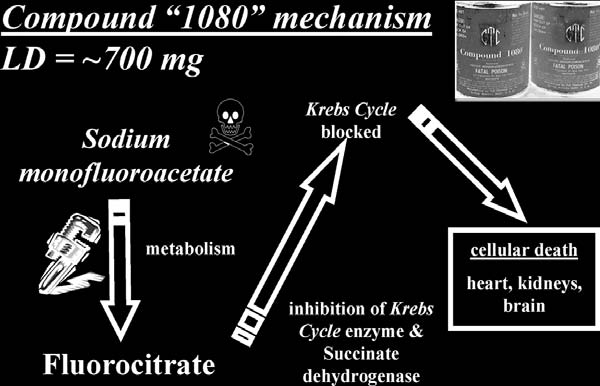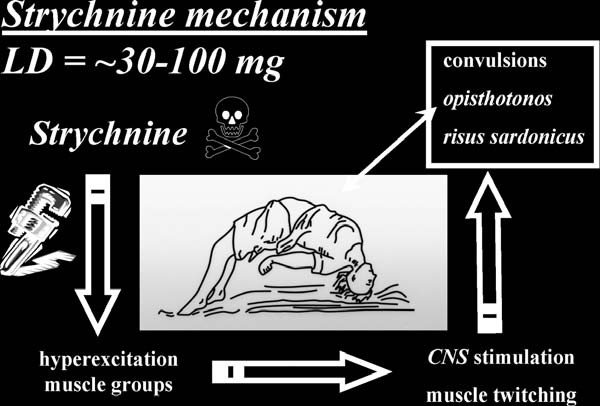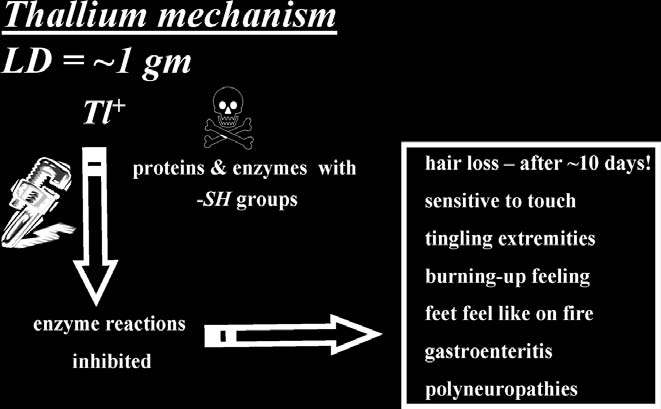Criminal Poisoning: Investigational Guide for Law Enforcement, Toxicologists, Forensic Scientists, and Attorneys (22 page)
Authors: John H. Trestrail

(
See
Fig. App. 4
.)
Poison Notes:
When providing mouth-to-mouth respiration support to a victim, care must be taken to avoid contaminating oneself. A toxidrome (pattern of symptoms) has been established for cyanide intoxication and includes altered mental status, mydriasis (dilated pupils), abnormal respiratory pattern, low systolic blood pressure, increased heart rate, metabolic acidosis, and a large increase in blood lactate.
120
Common Homicidal Poisons
Victim of Cyanide
Administered:
Often administered to victim in food or drink.
Symptom Onset Time Interval:
Immediate (as little as 30 s). Few poisons are as rapidly lethal.
Symptoms—Acute:
Headache, nausea, vomiting, difficulty breathing, and confusion. These initial symptoms are rapidly followed by seizures, coma, gasping respirations, and cardiovascular collapse.
Symptoms—Chronic:
Not applicable.
Disease Confusion:
Heart attack, acute asthmatic attack.
Victim Notes:
An abrupt onset of profound symptoms after exposure is classic for cyanide exposure.
Detection of Cyanide
Specimens:
Food, beverages, medications, blood, urine, gastric contents, and autopsy organ specimens.
Method:
Colorimetric techniques.
Toxic Levels:
(1)
Blood
Urine
Gastric
Other
12.4 mg/L
0.1 mg/L
Unknown
Unknown
Analysis Notes:
Toxic levels of cyanide in tissues may diminish significantly after death by mechanisms that include evaporation, thiocyanate formation, and reaction with tissue components. The formation of cyanide in postmortem tissues with accumulation to toxicologically significant levels apparently from the conversion of thiocyanate to cyanide has been demon-strated but can be prevented by the addition of sodium fluoride. Blood specimens should be kept at temperatures from 20 to 4°F, to reduce losses.
Selected Cyanide Homicide Cases
Theodosius Boughton (1781)
Dr. Collidge (1847)
Mrs. MacFarland (1911)
Twigg/Elosser (1911)
Jessie Costello (1933)
SODIUM FLUOROACETATE
Form:
Looks like flour or baking soda. Sodium fluoroacetate (also known as sodium monofluoroacetate, Furatol, Ratbane 1080, or Compound 1080).

Appendix
121
Figure App.-5
Another compound is Sodium fluoroacetamide (also known as Fluorakil, Fussol, Megarox, ancock, or Compound 1081). It is also the toxic constituent of the South African plant Giftblaar (
Dichapetalum cymosum
).
Color:
White, crystalline compound.
Odor:
Odorless.
Solubility:
1080 is very water soluble but has a low solubility in ethanol.
Taste:
1080 is mostly tasteless, but very dilute solutions may have a vinegar-like taste, owing to the acetate component.
Source:
Pesticides, rodent poison, and predator (coyote) poison. NOTE: It is sold only to licensed pest-control operators and others qualified by training and experience in rodent-control procedures. It is usually mixed with black dye and added to grain baits.
Lethal Dose:
acute, 2–10 mg/kg, 700 mg/150-lb victim; chronic, not applicable.
How It Kills:
The salt’s metabolite, fluorocitrate, blocks normal enzyme mechanisms in the body, acting mainly on the heart and central nervous system.
(
See
Fig. App. 5
.)
Poison Notes:
As little as 1 mg of 1080 is sufficient to cause serious poisoning. This is one of the most toxic substances known, and there is no specific antidote.
122
Common Homicidal Poisons
Victim of Sodium Fluoroacetate
Administered:
1080 can be administered to the victim in food or drink.
It can also be absorbed through broken skin.
Symptom Onset Time Interval:
Symptoms are delayed while the body converts the compound into the more toxic metabolite. Compound 1080: from 30 min to several hours; Compound 1081: slower onset of symptoms.
Symptoms—Acute:
Nausea, vomiting, diarrhea, agitation, confusion, seizures, lethargy, coma, respiratory arrest, and cardiac arrhythmias.
Symptoms—Chronic:
Not applicable.
Disease Confusion:
Gastroenteritis, viral infection, heart attack.
Victim Notes:
None.
Detection of Sodium Fluoroacetate
Specimens:
Blood, urine, and gastric contents.
Method:
Specific gas chromatographic procedures for the identification of fluoroacetate in biological specimens have relied on flame ionization, electron capture, or mass spectrometric detection of a derivative. There has been a report for a method for high-pressure liquid chromatography on gastric contents.
Toxic Levels:
(1)
Blood
Urine
Gastric
Other
Unknown
65 mg/L
12 mg/L
Liver: 58 mg/kg
Analysis Notes:
None
Selected Sodium Fluoroacetate Homicide Cases
No cases on record.
STRYCHNINE
Form:
Strychnine is an alkaloidal plant compound obtained from the tree
Strychnos nux-vomica
. The seeds are gray-green discs (1-in. in diameter, 0.25-in. thick at the rim) with a central depression and a satin-like appearance. Pure strychnine alkaloid is a white powder.
Color:
White, crystalline powder.
Odor:
None that is characteristic.
Solubility:
Soluble in aqueous solutions.
Taste:
Strychnine is extremely bitter, with a taste that is detectable at a dilution of 1:100,000. Strychnine could be administered in alcohol if the victim is accustomed to bitter drinks (e.g., tonic water). Strychnine can also be introduced into foods that normally have a sour or bitter taste.

Appendix
123
Figure App-6
Source:
Rodenticides (concentrations >0.5% are currently distributed only to licensed exterminators). Strychnine is sometimes found as an adulter-ant in illicit drugs. At one time, strychnine was sold over the counter as an ingredient in a variety of stimulant tonics and laxatives.
Lethal Dose:
Acute, 5–8 mg/kg, 30–300 mg (oral); chronic, unknown.
How It Kills:
Respiratory arrest.
Poison Notes:
None.
(
See
Fig. App. 6
.)
Victim of Strychnine
Administered:
Can be given in food, beverages, or medications.
Symptom Onset Time Interval:
15–30 min (oral route), 5 min (iv or nasal route).
Symptoms—Acute:
Muscle stiffness and painful cramps, which pre-cede generalized muscle contractions. The victim’s body may take the form of an arch (with only the head and heels touching the floor)—this is called an “opisthotonic” convulsion. The face may be drawn into a forced smile or sardonic grin called “risus sardonicus.” The muscle contractions (spasms) are intermittent and can be easily triggered by emotional or physical stimuli (sound, touch, light). Death is usually owing to respiratory arrest.
Symptoms—Chronic:
Not applicable.
Disease Confusion:
Grand mal seizures, tetanus.
124
Common Homicidal Poisons
Victim Notes:
Strychnine does not cause true seizures, and the victim is awake and painfully aware of the contractions.
Detection of Strychnine
Specimens:
Food, beverages, medications, blood, urine, gastric contents, and autopsy organ specimens.
Method:
Colorimetry, ultraviolet spectrophotometry, or GC.
Toxic Levels:
(1)
Blood
Urine
Gastric
Other
21 µg/mL
9.1 µg/mL
61 µg/mL
Unknown
Analysis Notes:
None
Selected Strychnine Homicide Cases
Christina Edmunds (1871)
Thomas Cream (1892)
Jean-Pierre Vacquier (1924)
Ethel Major (1934)
Floyd Horton (1937)
Patsy Wright (1987)
THALLIUM
Form:
Thallium in elemental form is a soft metal. Thallium can also exist as metallic salts (acetate, carbonate, chloride, sulfate, and so on).
Color:
Thallium salts are white crystalline powders.
Odor:
Odorless.
Solubility:
Thallium salts are readily soluble in water.
Taste:
Tasteless.
Source:
Thallium can be used as a rodenticide and an insecticide, but the use is restricted to licensed applicators (public use prohibited since 1965).
Thallium salts are widely used in industry (manufacture of optical lenses, photoelectric cells, costume jewelry) and chemical analyses. It has no known biological function in the body.
Lethal Dose:
Acute, 1 g, 12–15 mg/kg; chronic, unknown.
How It Kills:
Thallium causes membrane depolarization by acting as a substitute for potassium in the sodium–potassium–adenosine triphos-phatase pump. Like arsenic, it binds to enzymes containing (
—
SH) sulfhydryl groups.
(
See
Fig. App. 7
.)

Appendix
125
Figure App-7
Poison Notes:
Thallium is one of the most lethal poisons and produces one of the highest incidences of long-term sequellae (mainly neurological).
Victim of Thallium
Administered:
Can be given in food, drink, or medications.
Symptom Onset Time Interval:
Thallium is rapidly absorbed through the skin, and mucous membranes of the mouth and GI tract. GI symptoms appear after a latent period of usually 12–24 h.
Symptoms—Acute:
Abdominal pain, anorexia, nausea, vomiting, diarrhea, delirium, depressed respirations, seizure, coma, and death.
Symptoms—Chronic:
Muscle weakness, atrophy, tingling and numbness in the extremities, peripheral neuropathy, painful legs, a feeling that feet are on fire, a burning feeling in the body, sensitivity to touch, Aldrich-Mees lines (3 to 4 wk post), and hair loss (a classic symptom; may appear after 2–4 wk).
Disease Confusion:
Viral disease, Guillain-Barré syndrome.
Victim Notes:
The victim is often misdiagnosed.
126
Common Homicidal Poisons
Detection of Thallium
Specimens:
Food, beverages, medications, saliva, blood, urine, gastric contents, hair, and autopsy organ specimens.
Method:
Flameless atomic absorption.
Toxic Levels:
Blood
Urine
Gastric
Other
0.5–11 mg/L
1.7–11 mg/L
Unknown
